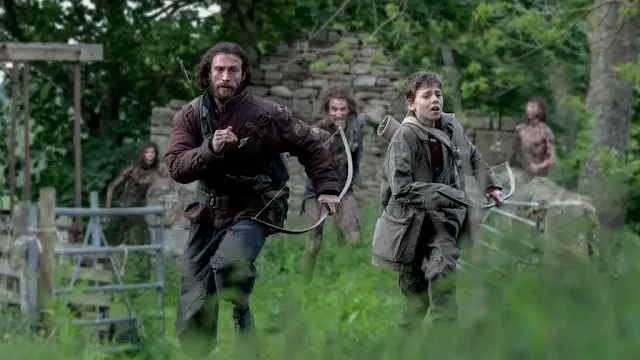On an island separated from the mainland by a causeway lives Jaime (Aaron Taylor-Johnson), one of the community's most skilled scavengers. He resides with his wife Isla (Jodie Comer), who is battling a mysterious illness, and their 12-year-old son, Spike (Alfie Williams). As part of the community’s coming-of-age ritual, Jaime takes Spike into the forest to teach him the art of survival and scavenging.
During their trip, they encounter different types of infected, from a fat one to a child. But the most terrifying of them all is an Alpha, a rare variant that is faster, stronger, and smarter than the typical infected. These Alphas are nearly impossible to outrun or outfight, making them a threat to be avoided at all costs.
While staying at an abandoned house, Spike spots a fire in the distance. Jaime mentions that it is probably Ian Kelson (Ralph Fiennes), a former survivor who now lives in isolation. According to locals, Kelson has lost his mind, and most people are afraid of him. However, Spike later discovers that Kelson is actually a doctor. With hope building inside him, he wonders if Kelson might be able to help treat his ailing mother.
Everything changes when Spike witnesses his father having an affair. The betrayal shakes him to the core and becomes the turning point of the story.
Spike decides to break the community’s rules to bring Isla to Kelson, risking everything to save her. With infected still roaming the land and the threat of Alphas making every step more perilous, Spike traverses the dangerous land with courage, love, and a bow in hand.
---
Watching 28 Years Later, you can really tell how far this franchise has come.
The progression of the story mirrors the evolution of the film’s visual style. What started with grainy footage from an inexpensive digital camera has now transformed into something more modern and bold. Danny Boyle shot this movie using one of the most accessible cameras available: an iPhone. That choice is fascinating and interesting, especially considering the scale of the film.
Surprisingly though, this film looks good!
We see extreme wide shots of abandoned lots and vast waters. Then, tight, emotional close-ups of the infected and the people reacting to them. Even though it was shot on a phone, the movie often left me in awe because it captures both landscape and emotion with stunning clarity.
There are also some creative shots here that most directors would never attempt in a horror film, especially when using a phone. Boyle calls it “poor man’s bullet-time,” you’ll know it when you see it. That kind of boldness though is part of what makes Danny Boyle such a thrilling director to watch and his creativity on limited resources adds to the franchise’s unique identity.
Like the first two film, the editing of 28 Years Later is also fast and disorienting. I love that the film never lets you stare at the infected for too long. You only get flashes and glimpses of them, which makes them even more terrifying in my opinion. The mystery and intensity of these brief encounters create a tension that feels dangerous and stays with you long after.
What makes 28 Years Later so effective is the film’s ability to find balance. It is not just about action. At its heart is a story about a mother and her son trying to save each other. The world around them is violent and unforgiving, but the film finds space to explore their relationship. They bring emotional weight to the chaos, and their journey is filled with sadness, fear, and hope.
You got to love the dialogue as well. It’s sharp and meaningful. The characters reflect on the world they live in, and at the same time, their words often feel relevant to our own. Without being too direct, the film reminds us how fragile life is and how easy it is to lose what matters most to us. It reminds us to keep moving forward and find reasons to live.
Unlike most sequels, you do not need to watch the first two films to enjoy this one. 28 Years Later stands on its own. Fans of the original entries will catch a few references here and there, but new viewers can jump in and still have a complete and fulfilling experience. If anything, this movie might even inspire you to go back and check the earlier films.
4/5


